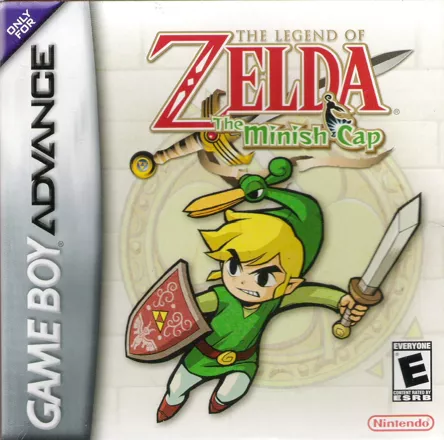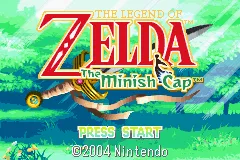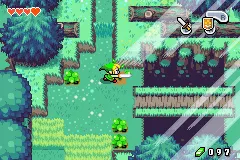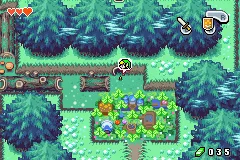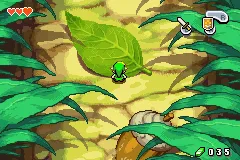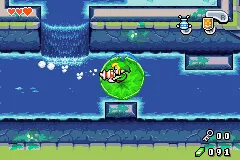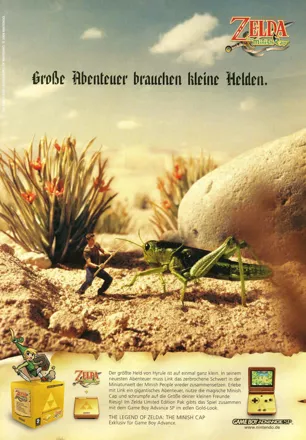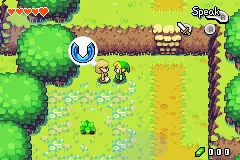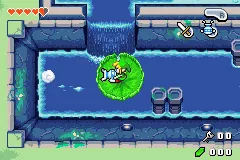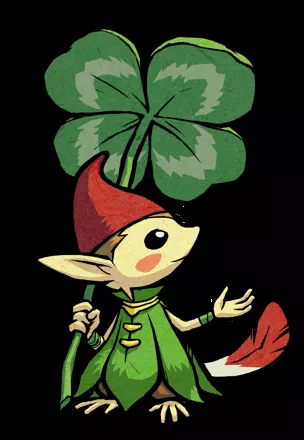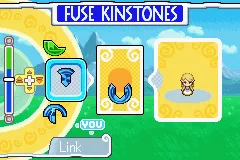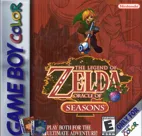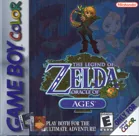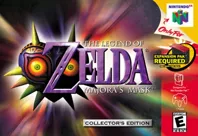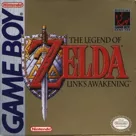The Legend of Zelda: The Minish Cap
Description official descriptions
While at a festival with Princess Zelda, Link encounters a mysterious mage, called Vaati, who turns the princess to stone. Helpless to stop them, Link is asked by the king to meet with a race of tiny people known as the Minish, who may be able to help with their predicament. On his travels, Link teams up with a talking cap called Ezlo, who is able to shrink Link to the size of a Minish so that he can meet with them. With his newfound abilities, Link must save the kingdom from Vaati's menace.
The Legend of Zelda: The Minish Cap is a top-down action adventure game that tells the origins of the evil Vaati from Four Swords. Players take on the role of Link as they conquer various dungeons to retrieve essential tools to fight enemies and progress through various obstacles. Items such as the Mole Mitts allow Link to dig through dirt, while the Gust Jar can be used to suck in enemies, items, and propel Link. Link can also shrink down to the size of a Minish with the aid of Ezlo, the talking cap.
The Minish Cap uses the gameplay mechanic of shrinking to make familiar territory new and different. Puddles become huge rivers, baby chicks are huge monsters, and regular enemies become deadly bosses at Minish size. Link can also trade items called "Kinstones" with people in the game - when two pieces of the same Kinstone are joined together, new areas open up, treasure chests appear, and sometimes, even useful rewards are given to Link.
Spellings
- ゼルダの伝説 ふしぎのぼうし - Japanese spelling
- 塞尔达传说:迷你帽 - Simplified Chinese spelling
Groups +
Screenshots
Promos
Videos
Add Trailer or Gameplay Video +1 point
See any errors or missing info for this game?
You can submit a correction, contribute trivia, add to a game group, add a related site or alternate title.
Credits (Game Boy Advance version)
60 People (54 developers, 6 thanks) · View all
| Director | |
| Planning | |
| Programming |
|
| Object Design |
|
| Scroll Design | |
| Music | |
| Sound Effects | |
| [ full credits ] | |
Reviews
Critics
Average score: 89% (based on 70 ratings)
Players
Average score: 4.2 out of 5 (based on 99 ratings with 3 reviews)
One of the Best Games for the GBA
The Good
Almost everything.
The Bad
It has less dungeons that previous Zelda titles, and fans may not like the new Kinstone system.
The Bottom Line
The Legend of Zelda: The Minish Cap was developed by Capcom (yes, Capcom) and published by Nintendo on January 10th, 2005.
So it turns out that Vaati’s intentions aren’t all that great. He turns Princess Zelda to stone and Link gets sent on a quest to retrieve a legendary sword forged by the Picori that can restore her. Why Link? Apparently, only children can see the Minish world of the Picori. And not only are the Picori invisible to adults, they’re also very, very small.
Everything about The Minish Cap is good. Like the music. Mixes range from the NES Legend of Zelda all the way to tunes from Ocarina of Time; many of the sound samples take their cues from Ocarina of Time and the Wind Waker respectively. If you find enough of a particular item you can unlock a means of hearing every song in the game, I was actually surprised to hear how close in quality the songs are to their console counterparts. I don’t know if the GBA’s sound capabilities are being maxed out or if the console sound is severely under utilized. Link’s little boy yell is ever present and sounds nearly as good as it does on GCN. Which is good.
Minish Cap is one of the best looking games on the GBA to date, taking after the toony Wind Waker style. Which is good. Many of the puzzles in this game require Link to shrink to Picori size. Watching out for the tiny Minish world while stomping around Hyrule brings a whole new dimension to the Zelda series. Minish Cap’s over-world is incredibly lush as a result, and when Link shrinks to Picori size you see just how much went into the level design. You’ll find yourself walking under gigantic leaves, climbing up gigantic bookcases, and treading the rafters of houses that are home to colonies of Picori. The trade-off is that Minish Cap doesn’t feature quite as many dungeon levels as previous Zelda titles, about six in all.
Shrinking aside, Minish Cap sticks close to the Zelda formula and plays just like you’d expect a Zelda game to play. (Good.) Basically, discovering the secrets of any given area hinges on the finding of certain items. Familiar items like the bow, and the bomb return. But there are also new additions like the Gust Jar, which allows you to vacuum up objects and enemies and clear away dust. Play mechanics remain largely the same as in previous installments, but there are some new puzzles that require Link to replicate himself. Another important new feature is the Kinstone; magical medallion halves that you can fuse together with the halves of NPC’s to uncover necessary and unnecessary secrets.
Because such emphasis has been placed on over-world exploration and the finding of Kinstones, it takes quite a while to find every last secret in Minish Cap. If you’re not into finding the little treasures that this game offers you’re still in for quite a good game. So much has gone into creating the Minish world in conjunction with Hyrule that even those who aren’t fond of collecting treasure will be sucked in. You won’t be able to resist climbing a beanstalk just once, or digging out an entire cave just to make sure you didn’t miss anything. This is certainly one of the best GBA games there is, not mention one of the best (goodest?) 2D Zelda games ever. I hope it’s not the last. A
Game Boy Advance · by 3ND3R (9) · 2005
A small handheld, a small hero, a small gem!
The Good
In this new Zelda adventure Link sets out on an adventure to defeat the evil wizard Vaati, who turned princess Zelda into stone and stop him from using her magic to turn himself into an all-powerful deity. Meanwhile the portal to the Minish World has opened. The Minish, or Picori are a race of thumb-sized beings that will help Link in his quest. Early on he meets Ezlo, a creature who has been turned into a strange hat. With Ezlo's help, Link can use special portals to shrink Link down to mini-size to enter Minish homes. The Minish live everywhere, from small holes in rocks to old shoes and even inside books.
This brings an interesting aspect to the gameplay, which is still strong. Mere puddles become deadly swamps when Link is small and tall grass or doorsteps block his way. On the other hand, this allows you to travel through small holes to reach otherwise inaccessible areas. This system is equivalent to the light and dark world from A Link to the Past or Ocarina of Time's present/future system. It is incorporated in many unique ways and gives you some very interesting puzzles to think about.
Another new aspect in this game are the Kinstone fusions. All around Hyrule, you can find Kinstone Pieces. These are stone fragments. If you find a person with a fitting piece, you will get something good. Sometimes a secret passage opens or a treasure chest appears. While not an addition that directly influences the gameplay or story, it is a nice addition that adds to the length and it is a lot of fun to find all matching pieces.
The overall gameplay is just classic Zelda, which is still an amazing formula. Fun bosses, interesting puzzles, addictive dungeon exploration and tons of little secrets to be found. Items play an important role as usual. New ones include the Gust Jar, which creates wind or can be used as a vacuum cleaner and the Mole Mitts, which allows you to dig tunnels. These items are well-thought off and add enough to the overall gameplay.
The graphical area is one where this game truly shines. Easily the best-looking 2D Zelda as well as one of the ovrall best-looking GBA titles. Everything is carefully crafted and detailed. The world is colorful and the animations are fluid. From the atmospheric Minish Woods to the sunny plains of Hyrule Field, this game is a delight to look at. It is made in the same great cartoon style as the Wind Waker and Four Swords (which was bundled with the GBA version of A Link to the Past). No complaints here!
There is enough to do after completing the game. Kinstone fusions, collecting all hearts, learning all techniques and find every weapon upgrade.
Sound is recognisable to the fans. Link's shouts and the puzzle-solving sound are all here. Music is crisp and clear and has both old and new tunes. All these tunes are ones you will be humming along soon. Yet another Zelda game to score well in this area.
The Bad
This game is far too easy! While, as mentioned, there is enough replay it is still a shame that the bosses are usually defeated easily once you find out how to do that.
This gets even worse when you discover this game is also really short, especially compared to A Link to the Past, which is also available for GBA. This title has only five main dungeons. No other Zelda title has had this few to this day. A real shame.
Lack of innovation to the classic Zelda formula.
The Bottom Line
An all-new Zelda title that is sure a delight to play, but don't expect the challenge that A Link to the Past/Four Swords provides or any drastic changes that directly affect gameplay.
Game Boy Advance · by Rensch (203) · 2008
The Minish Cap: One of my favorite titles that still stands as a great game
The Good
The story is similar to other Zelda games, the sprite work is gorgeous, and the music is catchy enough to make you hum along.
The Bad
As a completionist, the Kinstone fusions cannot be 100% completed if you wait until the end of the game.
The Bottom Line
The Legend of Zelda: The Minish Cap is one of my favorite games of all time. It’s one of those games that I can enjoy playing again and again. Funnily enough, when it first came out, even though I enjoyed games in the Zelda series, I had no idea that the game had come out or what it was until my parents randomly bought copies of it for my brother and I one fateful day. It may be the case for some that this game can’t be played more than once due to lack of interest or simply the fact that one playthrough is enough, but I still enjoy playing through this game even after playing though about five or six times. I hope to explore what makes The Minish Cap such a quality game.
The story of The Minish Cap is not unlike any other Zelda title. Something bad is happening in Hyrule that involves Princess Zelda, and it’s up to Link to set things right. In this particular game, you begin as the apprentice of a blacksmith named Smith. You wake up one morning to find Princess Zelda, who in this game is Link’s childhood friend, asking Smith if you can accompany her to the Picori Festival in Hyrule town. The Picori Festival is to celebrate the legend of the Picori (Picori being the official name in the lore for the Minish) and is held every year as thanks to the Picori for helping the Hero of Men seal away the evil that once ruled in Hyrule. Smith sends Link off to the festival with Zelda to deliver a sword to be presented to the winner of a sword fighting competition. The winner of this competition is a strange man named Vaati. As another reward for winning the competition, Vaati is presented with the Picori Blade, the sword that the Picori gave to the Hero of Men. The sword is mounted on top of a box as a seal to keep the evil contained within. Vaati, in searching for the ultimate power known as the Light Force, breaks the sword to open the sealed box. Much to Vaati’s surprise, the Light Force is not in the box, but lives inside Princess Zelda. Not knowing this yet, Vaati turns Zelda to stone and flees in search of the Light Force. The only way to cure Zelda of her petrification is to use the power of the Picori Blade, which is now broken. Since the only ones who can repair the Picori Blade are the Picori themselves, Link must set off on a quest to find them and have them repair the blade. Link is chosen for this quest because the Picori only reveal themselves to children. The sword that Link was to deliver is given to him to use on his quest. Link is sent to the Minish Woods to look for the Picori. In searching through the woods, Link finds a mysterious talking hat named Ezlo, who is later revealed to be a Minish sage and the mentor of Vaati. As a hat, Ezlo joins Link on his journey atop Link’s head and offers advice throughout the journey. In joining Link, Ezlo gives him the familiar appearance of the Hero of Time seen in earlier games. In addition to repairing the blade, Link must restore the blade’s former power by collecting the four Elements of the world, which can be found in the four main dungeons of the world. After all of the Elements are found and used with the blade, the Picori Blade becomes the Four Sword, which allows Link to cure people of petrification and split into four copies to solve puzzles.
The story is the main thing that drives the game experience forward because without a story, Hyrule becomes just a huge area to roam around in. There are other things the player can do, but they are just simple mini-games that don’t do anything important for the story. Because of this, a cohesive story must be present to keep the player going throughout the entire game. Thankfully, Zelda titles are generally pretty good at doing this. As the story progresses, the player is led through separate areas that are vastly different from each other. This was one aspect of the game that stood out to me, especially the first time I played through the game. Since each area had a unique look to it, I was always excited to find out where I was going next. Tying this in with the look of the game, The Minish Cap is very colorful and pleasing to look at, making the appeal of each new area that much more interesting. The music in each area follows this trend as well and each track adds to the feel of the area associated with it.
Since The Minish Cap is a fairly late entry in the Zelda series, it might be expected that players are familiar with the rules of a Zelda game. However, this game also shows new players how to play it. In the beginning of the game, you actually don’t have a sword because it is not needed at that point. There is only one monster, and there is another way to fight it that the game shows you. Princess Zelda wins a shield from one of the festival activities and gives it to Link. After spending sometime at the festival, Princess Zelda takes Link to Hyrule Castle to deliver the prize sword to be presented after the sword fighting competition. On the way to the castle, Zelda and Link encounter a roadblock caused by a Business Scrub, which is a plant creature that spits nuts out of its mouth as an attack. Zelda is struck by a nut and asks Link to use his shield to deflect it back at the Business Scrub. The player then presses A or B to hold up the shield, which is indicated by the A and B buttons on the interface, and causes the Business Scrub to go away when hit with his own attack. This shows that some enemies can be killed by simply using the shield. Other acquired items are not explained in such depth, but are instead described as soon as you get them. An example of this is when you get Smith’s Sword to aid you on your quest. A text box appears and tells you the name of the item followed by what it is used for and how to use it. Another way information is conveyed is through highlighted keywords that appear in the text boxes. These words provide subtle hints to the player as to what to do next.
The menu and item system in this game is very similar to the system used in Oracle of Ages, Oracle of Seasons, and Link’s Awakening for Game Boy Color. Any item can be assigned to the A or B buttons, so you can only have two items equipped at one time. While sometimes frustrating to have to switch items when you need several one right after each other, all puzzles can be solved using two items together at most. The R button is an action button of sorts and can be used in place of the A button to talk to people or interact with objects. On the interface, the R button is shown in the top right corner and normally has text on top of it to show what that button will do at the time. While walking, “roll” will appear on top of it showing that the player can press R to do a somersault. When standing in front of a person, “talk” will appear showing that you can talk with the person. There are several other words that appear as well, all representing different actions. The L button is used in the game to fuse Kinstones, objects found while exploring that can be fused with their other halves to make something interesting happen, like make a treasure chest appear somewhere in the world or open a small cave for exploration. While the L button is used, it is not shown on the interface with the A, B, and R buttons. Instead, if a Kinstone fusion is possible with a person, facing them at close range will make a thought bubble appear over their head. The other elements of the interface display information about the player. Player health is represented by hearts in the top left corner, increasing up to twenty when all Heart Containers and Heart Pieces are discovered. The amount of Rupees (money) the player has is represented by a number in the bottom right corner next to a small Rupee that changes color as you get bigger wallets. When inside a dungeon, the number of keys you have with you is shown directly above the Rupee counter along with a symbol of a key. The interface is simple and does not obscure the view of the game, but still it offers quite a bit of information.
As I said before, the game uses the appearance of each area in addition to the story to drive the player forward. The sprite work of the game looks very nice and polished, creating an atmosphere in which players will want to spend quite some time. However, the world of The Minish Cap is small compared to most other Zelda games. Because of this, and since the game would be much shorter otherwise, the game has players do small side quests in between main points of the story to extend game time. This usually occurs in the way of getting a new item so that you can explore a new area. One example is having to go back to the Elemental Sanctuary in Hyrule Castle after each acquisition of a new Element to power up the Picori Blade. Each time the sword is powered up, Link can make one more copy of himself in areas where copies are necessary. Certain puzzles can be solved with just one copy, but other puzzles need two or even the full three copies in order to be solved. Another example is an area called Castor Wilds, which is a swampy area that cannot be traversed without the Pegasus Boots. After Link gets to this area and discovers that he cannot get through the swamp fast enough without being swallowed, he must turn around and find the shoemaker in town that can make the Pegasus Boots. However, the shoemaker falls asleep as soon as you get there and Link must embark on another side quest to find a Wake-Up Mushroom to wake up the shoemaker. After getting the Pegasus Boots, Link can return to Castor Wilds to continue the main quest. With the back and forth of the side quests and the sprawling reach of the main quest, the game gets much use out of a small world. Also, because the world is small, the side quests usually don’t take very long, so the player can get back to the main quest in a short time.
Going back to the way the game looks, the unique appearance of each area creates many different feelings in such a small space. If you look at a map of the entire game world pieced together, it looks a bit strange because of how the different colors of each area meet. However, you never see these harsh borders in the game because the screen fades to white when changing major areas. This actually makes the world feel bigger than it is because it makes the major areas feel farther apart than they actually are. There is one screen between Hyrule Town and a huge mountainous area called Mt. Crenel, but it feels so far away because it looks so different. I think that this is a good use of space in the game. The music that accompanies each area makes for a great adventure soundtrack. Some areas have heroic sounding music, Hyrule Town has happy music, and some of the darker areas have music that is eerie and creepy. It also adds to the illusion of vastness of the world because like the aesthetics of the areas, each track is different from the others. As an added bonus, some of the songs are catchy and can make you hum along with them.
I think what makes The Minish Cap a good game is the feeling of adventure and how big the world feels, even though it’s really not. Even though the main quest isn’t that long, there are a few other distractions in the game that can keep a player interested for a while. The driving force is still the story because without it, there is not much direction in the game. The different areas augment the story by giving the game a real sense of adventure, but without the story they become something that is only worth looking at. The dungeons are fun, as they should be in a Zelda game, and the continual discovery of things in the game adds to the player staying involved.
Game Boy Advance · by Andrew Marion (4) · 2014
Trivia
1001 Video Games
The Game Boy Advance version of The Legend of Zelda: The Minish Cap appears in the book 1001 Video Games You Must Play Before You Die by General Editor Tony Mott.
Glitches in the PAL version
The European and Australian versions of The Minish Cap are possibly the most buggy Zelda games to date due to two serious glitches. One of them is the missing bomb bag upgrade in Stockwell's shop. This upgrade cannot be purchased, because it does not appear on the shelf after purchasing the Boomerang. This leaves you unable to obtain 99 bombs, leaving you only with 50 (including both other upgrades). Workaround for this glitch does not exist.
Other serious glitch involves the beginning of Goron Sidequest. After visiting Castor Wilds for the first time, it's possible to perform a Kinstone Fusion with an NPC named Eenie on Eastern Hills. However, there is a glitch - if you try to perform a fusion, cancel it (e. g. because you don't have required Kinstone piece), leave the screen and come back, performing this fusion will be impossible. Unlike the bomb bag upgrade glitch, this one can be avoided.
The game also contain few more minor glitches, like missing tornado on Lon Lon Ranch or misleading Ice Wizzrobe figurine description. Unfortunately, all of these glitches are still present in the 3DS version, released for the members of the Ambassador Program.
Minish Cap
The Minish Cap has a name, which is Ezlo.
Awards
- GamePro (Germany)
- February 2004 - Best Handheld Game in 2004 (Readers' Vote)
- GameSpy
- 2005 – #9 Game of the Year
- 2005 – GBA Game of the Year
- 2005 – GBA Game of the Year (Readers' Vote)
- 2005 – GBA Adventure Game of the Year
Analytics
Related Sites +
-
The Legend of Zelda: The Minish Cap
The official Nintendo website for the game.
Identifiers +
Contribute
Are you familiar with this game? Help document and preserve this entry in video game history! If your contribution is approved, you will earn points and be credited as a contributor.
Contributors to this Entry
Game added by TReMMoR.
Nintendo 3DS added by ResidentHazard. Wii U added by Michael Cassidy.
Additional contributors: Unicorn Lynx, Riamus, gamewarrior, Patrick Bregger, Piotr Józefowicz, FatherJack.
Game added December 30, 2004. Last modified May 29, 2024.


